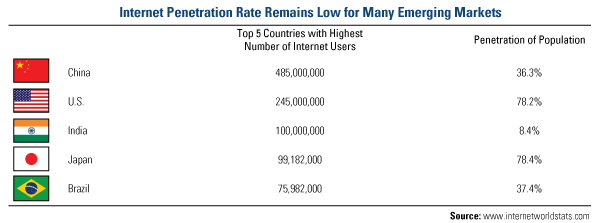All those irrational investors who hyped up the internet in the late 90’s might have been on to something after all. And as is generally the case, they were a bit too eager and greedy to wait for the secular trends in the adoption and growth of the internet. If you live in a developed world economy you might be inclined to believe that internet usage is becoming increasingly saturated, but when we step back and look at the global trends we see a world whose internet growth is still very much in its early stages. In a recent report US Funds provided an excellent overview of three massive secular trends in favor of a very bullish story for internet growth:
“1. Only 35 percent of the world’s population uses the Internet today. Yet, of those on the Web, the majority currently lives in a developing country.
2. China has the largest number of Internet users—485 million to be exact—but this is only one-third of the country’s population. After the U.S., India comes in third with 100 million users, but this is less than 10 percent of its population. Brazil holds the number five position with nearly 76 million users—only one-third of its population.
3. The adoption of smartphones is expected to grow rapidly in emerging markets. According to Bloomberg News, within a four-month timeframe, five million Chinese bought Apple’s iPhone 4 from China Mobile. The company plans to have 1 million new Wi-Fi hotspots across China over the next three years, says Bloomberg, so the consumer can surf the Web via Wi-Fi without having 3G access.”

Bet against the future of the internet at your own peril. Just be sure not to fall for the fly by night companies offering gimmicky business models….
Source: US Funds
Mr. Roche is the Founder and Chief Investment Officer of Discipline Funds.Discipline Funds is a low fee financial advisory firm with a focus on helping people be more disciplined with their finances.
He is also the author of Pragmatic Capitalism: What Every Investor Needs to Understand About Money and Finance, Understanding the Modern Monetary System and Understanding Modern Portfolio Construction.

Comments are closed.